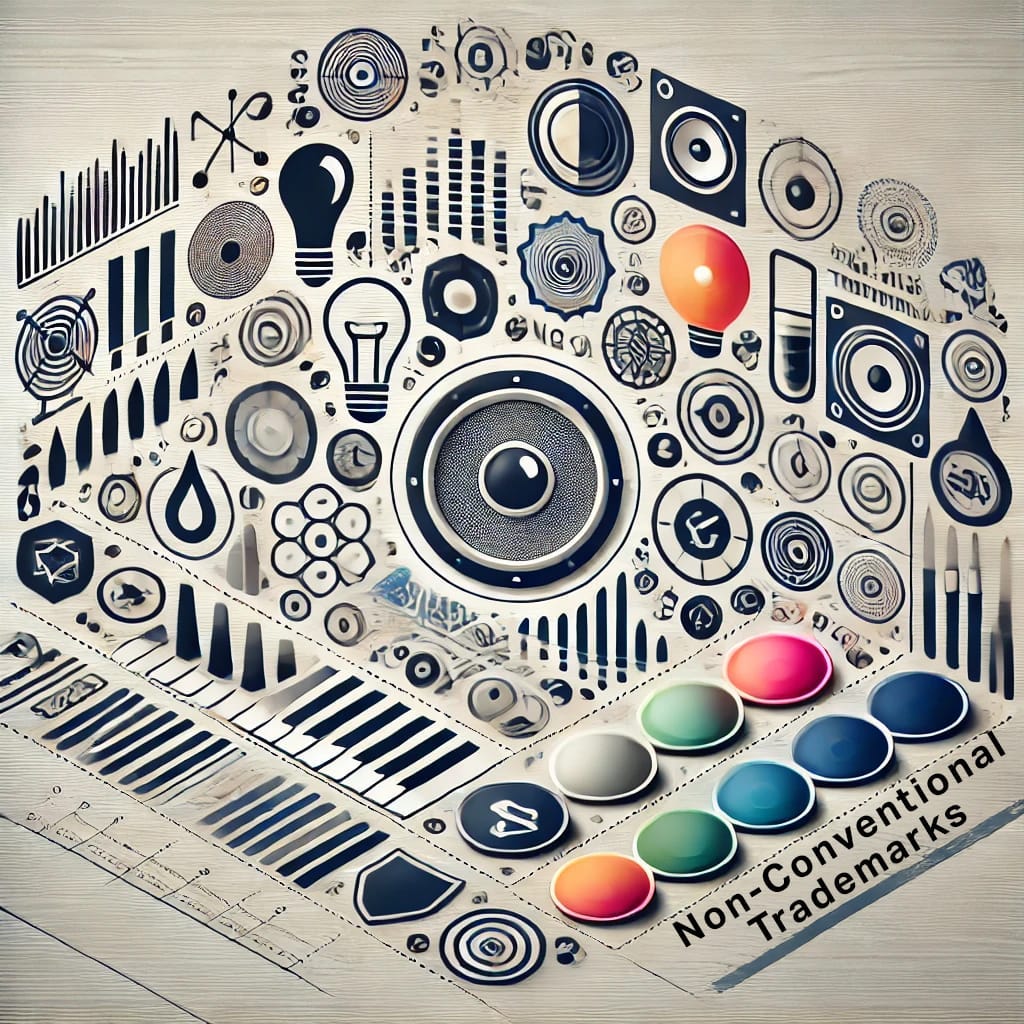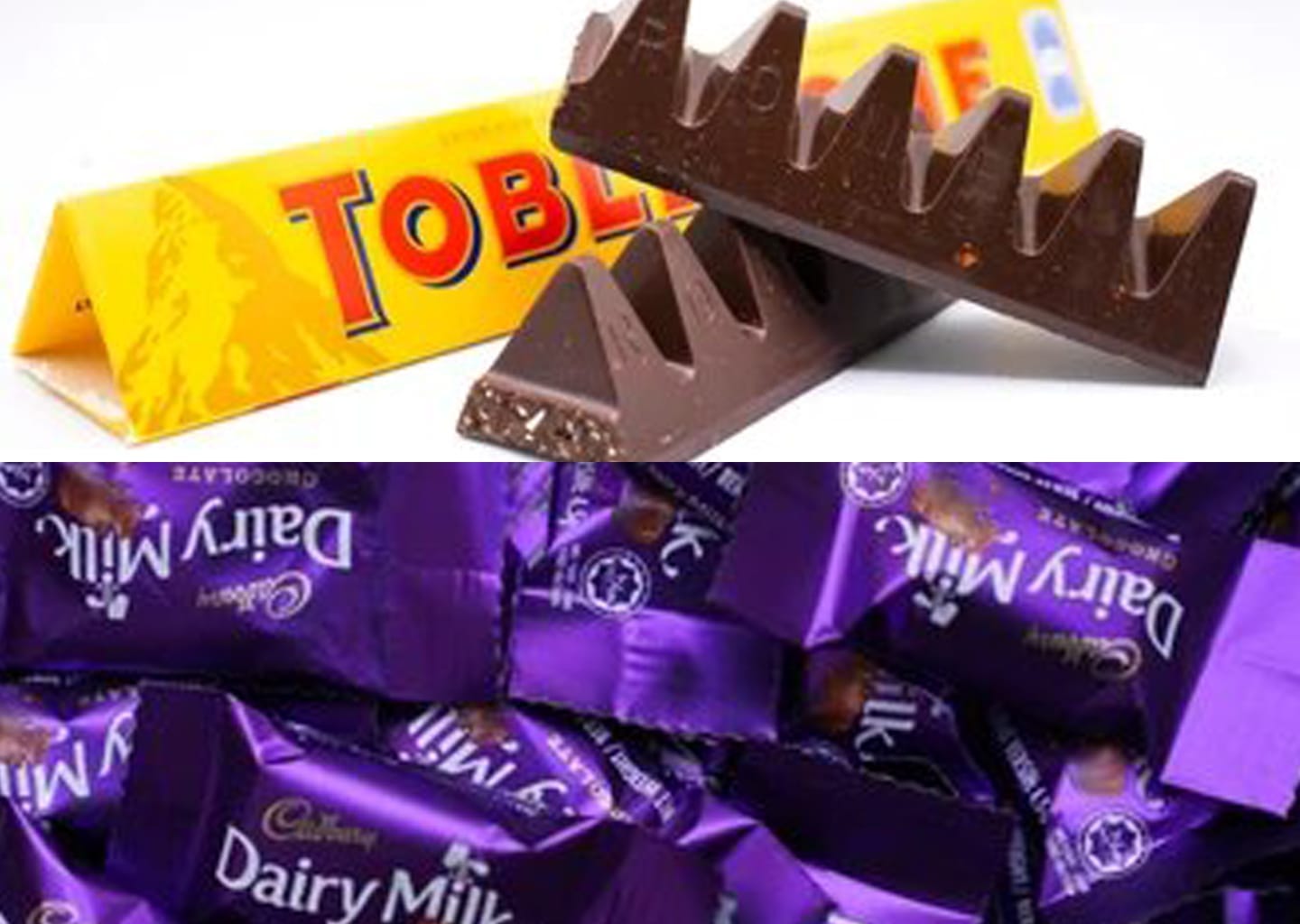From Sound to Scent: The Growing Influence of Non-Conventional Trademarks in Global Branding
IP Wave 04 12 produced using Adobe AI Generator by ASIA
0:00
/1467.792
1×

What Are Non-Conventional Trademarks?
Non-conventional trademarks (NCTs) are transforming branding by moving beyond the traditional reliance on logos, symbols, and names. These trademarks create a deeper connection with consumers by engaging multiple senses—sight, sound, touch, smell, taste, and even motion. Rather than relying solely on visual recognition, NCTs offer a rich, multi-sensory experience that leaves a lasting impact, helping brands stand out in an increasingly crowded marketplace.
One of the most powerful examples of NCTs is sound marks. Distinctive sounds, such as Intel’s signature five-note chime and Nokia’s iconic ringtone, instantly trigger brand recognition, even in the absence of any visual cues. These sounds act as shortcuts to brand identification, creating an immediate mental link to the brand without the need for logos or text.
Colors are a key element in non-traditional branding. Tiffany & Co.’s signature blue, for instance, is immediately associated with luxury, exclusivity, and elegance, while Cadbury’s deep purple reinforces its identity as a premium chocolate brand. Although registering color marks can be challenging due to the need to prove distinctiveness over time, when successful, color trademarks become powerful tools in shaping how consumers perceive a brand.
Shape marks highlight the impact of non-traditional branding as well. Coca-Cola’s famous contoured bottle and Toblerone’s unique triangular chocolate bar are instantly recognizable, even without text or logos. These shapes go beyond mere functionality; they are integral to the brand’s identity, showing how distinctive forms can act as symbols of the brand itself.
Scent marks, though less common due to the difficulty in representing smells graphically, still hold significant potential. Play-Doh’s sweet vanilla fragrance, for example, evokes feelings of nostalgia and strengthens the brand’s playful, child-friendly image. Similarly, the refreshing citrus scent in Singapore Airlines cabins adds an extra layer to the sensory experience, building customer loyalty and boosting brand recognition.
In a marketplace where emotional connection plays a critical role, NCTs provide brands with the opportunity to form lasting relationships with consumers. A simple sound, like Intel’s chime, or a scent, like Play-Doh’s fragrance, can trigger emotions such as trust or nostalgia, deepening the bond between the consumer and the brand. Coca-Cola’s distinctive bottle shape offers tactile recognition, creating familiarity that enhances the brand’s immersive experience.
The legal protection of NCTs is essential in maintaining their value, allowing companies to safeguard their unique sensory elements from imitation. By trademarking sounds, colours, or shapes, brands protect their identity and open doors for expansion. For example, a registered fragrance can be extended across various product categories, from perfumes to candles, ensuring a cohesive and consistent brand experience.
As digital branding continues to grow, NCTs are increasingly making their mark in virtual spaces. Sound and motion marks are becoming indispensable in digital branding strategies. Netflix’s iconic “ta-dum” sound, for instance, has become a recognized trademark, signalling high-quality content and an engaging user experience. NCTs are now essential for creating unforgettable digital experiences, alongside their role in enhancing physical product branding.
Legal Framework for Non-Conventional Trademarks
The legal treatment of non-conventional trademarks (NCTs) differs widely across the globe, with various jurisdictions adopting distinct approaches to recognizing and protecting these sensory-based marks. International treaties, like the TRIPS Agreement, set broad guidelines for trademark protection, but it is national laws that define the specific criteria for registering NCTs. As a result, some countries are at the forefront of innovation in this area, while others continue to adhere to traditional standards.
International Recognition
On the international stage, the Agreement on Trade-Related Aspects of Intellectual Property Rights (TRIPS), under the World Trade Organization (WTO), offers a broad definition of trademarks in Article 15. It allows any sign that can distinguish goods or services to qualify as a trademark. The agreement emphasizes distinctiveness and functionality, without specifically requiring a graphical representation. This opens the door for the protection of non-traditional marks like sounds, smells, and colours. However, how these provisions are put into practice varies greatly between countries.
European Union
The European Union has taken significant strides in recognizing non-conventional trademarks. Under the EU’s trademark framework, governed by Directive 2015/2436 and Regulation 2015/2424, the requirement for a graphical representation of marks was removed, marking a major shift in the protection of non-visual trademarks. The landmark Sieckmann v. Deutsches Patent und Markenamt case was a turning point, establishing that marks must be clear, precise, intelligible, and durable. This decision laid the foundation for the acceptance of sensory marks, though challenges remain—particularly with olfactory marks. While certain scents, like the smell of freshly cut grass for tennis balls, have been accepted, others have struggled to meet the criteria set forth by the court. On the other hand, sound marks have been easier to register, with cases like Shield Mark BV v. Joost Kist affirming that musical notation or audio recordings are sufficient for trademark registration.
United States
The United States has adopted a relatively flexible approach to non-conventional trademarks, particularly under the Lanham Act. Rather than requiring a graphical representation, U.S. trademark law focuses on the distinctiveness and non-functionality of the mark. A pivotal case in this regard was Qualitex Co. v. Jacobson Products Co., which allowed a color (green-gold) to be trademarked for dry-cleaning pads, setting an important precedent for color marks. Additionally, sensory marks such as sounds and scents have been successfully protected. For example, NBC’s iconic chimes, MGM’s lion roar, and the scent of plumeria blossoms for sewing thread have all been recognized. The emphasis in the U.S. is on consumer recognition and acquired distinctiveness, which has created an environment where creative and unconventional marks can thrive.
Indian Legal Framework
In India, trademark law is governed by the Trade Marks Act, 1999, and the Trade Marks Rules, 2017. These laws recognize certain non-conventional trademarks, such as sound, color, and shape marks. Section 2(1)(zb) of the Act defines a trademark as any mark capable of being graphically represented and capable of distinguishing goods or services. Rule 26 of the 2017 Rules allows for sound mark registration, provided the mark is submitted as an MP3 file along with musical notation. This was first demonstrated in the case of Yahoo Inc. (2008), where the Yahoo yodel became India’s first registered sound mark. However, the requirement for graphical representation has limited the recognition of marks like scents and tastes. This graphical representation requirement places India’s approach closer to the European model, where similar limitations exist, rather than the more flexible stance seen in the U.S. As a result, there is significant potential for India to reform its trademark law to provide broader protection for non-conventional trademarks, particularly those based on sensory elements beyond visual representation.
Challenges in Registering Non-Conventional Trademarks
Non-conventional trademarks (NCTs) provide unique branding opportunities, but the process of registering them can be fraught with challenges. These hurdles arise from both the inherent nature of NCTs and the limitations of traditional trademark laws, which were not originally designed to accommodate sensory-based identifiers. The key obstacles in registering NCTs include:
Graphical Representation
One of the primary challenges in registering non-conventional trademarks is the requirement for graphical representation. This becomes particularly problematic for sensory marks like scents, tastes, and textures, which do not easily translate into standard visual formats. For example, while sound marks can be represented using musical notation, representing something intangible like a smell or a texture that meets the legal criteria is much more difficult. The landmark Sieckmann case in the European Union highlighted this issue, ruling that olfactory marks must be represented in a clear, precise, and durable manner. While suggestions such as chemical formulas or descriptive text have been proposed for scent marks, they often fall short of capturing the true sensory experience. This challenge is further complicated in countries like India, where the Trade Marks Act, 1999, mandates a graphical representation for all marks.
Distinctiveness
A trademark must be distinctive to qualify for registration, meaning it should be able to uniquely identify a product or service. This requirement can be particularly tricky for sensory marks, as many sensory elements are inherently tied to the product itself. For instance, a lavender scent for air fresheners may not be considered distinctive enough because it is seen as a functional or descriptive feature, rather than a unique identifier of a brand. Legal cases, such as Nestlé v. Cadbury, show how challenging it can be to prove consumer association, especially when marks are functional or tied to the product's nature, such as certain shapes or colors.
Functionality Doctrine
The functionality doctrine is another significant barrier for registering sensory marks. This principle holds that you cannot register a trademark if it is essential to the function or use of the product. For example, in the Louboutin v. Yves Saint Laurent case, the court ruled that Louboutin’s red sole trademark could only be used for shoes with contrasting soles, as the red sole’s aesthetic appeal was considered part of the shoe's functionality. Similarly, tactile marks, like textures, often face the same challenge, as they are frequently viewed as functional features of the product rather than distinctive identifiers.
Evidentiary Challenges
Proving that a non-conventional trademark has acquired distinctiveness is a critical part of the registration process, but it often requires substantial evidence, such as consumer surveys, sales data, or significant marketing efforts. Gathering such evidence can be expensive and time-consuming, creating a barrier for smaller businesses with limited resources. This evidentiary requirement adds complexity to the process, as applicants must demonstrate that their sensory mark is truly associated with their brand in the minds of consumers.
Cultural and Jurisdictional Variances
Sensory perceptions are inherently subjective and can vary widely across different cultures and regions. A color that represents luxury in one culture might have an entirely different meaning in another. For example, while white is often associated with purity in Western cultures, it may symbolize mourning in certain parts of Asia. These cultural differences can make global registration of NCTs more complex, as marks that are distinctive in one region may not have the same recognition or significance in others.
Judicial Ambiguities
In jurisdictions like India, inconsistent judicial interpretations further complicate the process of registering non-conventional trademarks. While some courts have recognized sound marks and color combinations, others have dismissed claims for single colors or functional shapes. This lack of consistency in rulings creates uncertainty for applicants, making it difficult to predict whether a specific NCT will be accepted or not. The legal framework for trademark protection has yet to fully evolve to accommodate these innovative identifiers, making the process of registration complex and uncertain for businesses.
Case Studies: Success and Precedents
The rise of non-conventional trademarks (NCTs) can be best understood through real-world examples and landmark cases, which highlight both the potential and the challenges associated with these unique forms of intellectual property across different regions.
Smell Marks
Although rare and difficult to register, smell marks demonstrate the potential of olfactory branding. A notable example in the European Union is the scent of freshly cut grass, which was successfully registered for tennis balls in the Vennootschap onder Firma Senta Aromatic case. This marked a significant step in demonstrating that olfactory marks could meet the necessary distinctiveness requirements. However, the Sieckmann v. Deutsches Patent und Markenamt case clarified that, for a scent to qualify for protection, it must be represented in a precise and durable manner, such as through chemical formulas or detailed descriptions.
In the United States, Play-Doh’s distinctive vanilla-like scent became one of the first recognized scent marks. The sweet, nostalgic aroma of the toy compound has become closely associated with the brand, further proving how sensory trademarks can create strong emotional connections and lasting memories for consumers.
Shape Marks
Shape trademarks have also gained prominence for their ability to distinguish products through unique and recognizable designs. One of the most iconic examples is Coca-Cola’s contoured bottle, which is not only visually distinctive but also has tactile recognition. This shape has become synonymous with the brand, reinforcing its status as an iconic and innovative product. Toblerone’s triangular chocolate bar is another successful example, where the shape itself has become an inseparable part of the brand’s identity.
In India, the case of Gorbatschow Vodka v. John Distilleries Ltd. emphasized the significance of shape marks in distinguishing products. The Bombay High Court upheld the distinctiveness of Gorbatschow vodka bottles, recognizing that unique product shapes can serve as powerful identifiers in the marketplace. However, the Nestlé v. Cadbury case in the UK presented a challenge to shape marks, where the court ruled against the registration of the Kit Kat bar’s shape, citing insufficient evidence that consumers associated the design exclusively with the brand.
Sound Marks
Sound marks have become some of the most recognizable and successful non-conventional trademarks, especially in industries like technology and entertainment. Intel’s iconic chime is one of the first globally recognized sound marks, demonstrating how auditory branding can transcend borders, connecting with consumers across different markets. In India, the "Yahoo Yodel" became a trailblazer for sound marks when it was successfully registered in 2008. This case set a significant precedent for the registration of sound marks in India, leading to other approvals, such as ICICI Bank’s corporate jingle.
Globally, sound marks like the MGM lion’s roar and NBC’s three-note chime have solidified their positions in popular culture. These auditory trademarks have become so deeply associated with their brands that they serve as powerful symbols, marking milestones in the development and recognition of non-conventional trademarks.
Color Marks
Color trademarks are another example of how a single hue or a combination of colors can carry significant brand identity. Tiffany & Co.’s signature Pantone 1837, known as Tiffany Blue, is a prime example of how a specific color can become synonymous with luxury and exclusivity. This color has been so consistently used across the brand’s packaging and store design that it has become an iconic element of the brand.
Cadbury’s purple packaging is another example that has faced legal challenges but ultimately triumphed, affirming its distinctiveness and association with premium chocolate products. In India, the Colgate Palmolive v. Anchor case highlighted the importance of colour combinations in distinguishing brands, with the Delhi High Court protecting Colgate’s red-and-white packaging. However, cases like Cipla Ltd. v. MKI Pharmaceuticals illustrate the complexities surrounding single-colour trademarks, as courts have been cautious in granting exclusivity over individual colours.
Motion Marks
Motion marks are becoming increasingly important in the digital age, where dynamic and animated elements are used to enhance brand recognition. The animated spotlight sequence in 20th Century Fox films and Netflix’s “ta-dum” sound, paired with motion visuals, are prime examples of how motion and sound together can create a powerful, instantly recognizable brand identity. In India, Sony Ericsson registered a motion mark that used a flipbook-style animation, demonstrating the evolving scope of trademark registration in the modern digital landscape.
These cases collectively highlight the growing importance of non-conventional trademarks in modern commerce. They also underscore the challenges that businesses and legal systems face in meeting the distinctiveness and representational requirements, particularly for non-visual marks. As branding continues to expand into sensory and digital realms, NCTs will undoubtedly play an increasingly significant role in shaping the future of intellectual property.
Evolving Indian Landscape
India’s trademark laws have made notable progress in recognizing non-conventional trademarks, yet there are still significant gaps that need to be addressed to accommodate the full range of these evolving intellectual property forms. The Trade Marks Act, 1999 and the Trade Marks Rules, 2017 have laid the groundwork for non-traditional marks, particularly for sound and color marks. However, the continued emphasis on graphical representation poses substantial challenges, particularly for marks like scents, textures, and tastes. This reliance on visual formats remains a major hurdle for the registration of sensory marks, particularly when there are no universally accepted ways to represent these sensory experiences. For instance, while sound marks can be represented by MP3 files or musical notation, scent marks often require chemical formulas, which fail to capture the full sensory experience as demonstrated in the Sieckmann case.
To align with global best practices, India would benefit from reforming this graphical representation requirement, especially considering that the European Union’s Directive 2015/2436 has removed this obstacle. Adopting a more flexible approach would allow Indian laws to better reflect the progressive trademark frameworks seen in jurisdictions like the EU and the United States.
Judicial decisions in India have played a crucial role in shaping the legal landscape for non-conventional trademarks. Cases such as Yahoo Inc. and ICICI Bank have established sound marks as a legitimate category under Indian law. Similarly, cases involving shape marks like Gorbatschow Vodka v. John Distilleries and color marks like Colgate Palmolive v. Anchor have reinforced the importance of distinctiveness and consumer association. However, the legal framework remains incomplete, particularly when it comes to texture, scent, and motion marks. These gaps need to be addressed to create a more comprehensive legal framework for NCTs.
Awareness campaigns are also essential in advancing the adoption of NCTs in India. Many businesses, especially small and medium enterprises, are still unaware of the commercial and legal value of these trademarks. Educating stakeholders about the benefits of sensory branding, along with practical guidance on registration and enforcement, could encourage broader adoption. Intellectual property offices, industry associations, and academic institutions can play a key role in bridging this knowledge gap, helping to create a more innovative and competitive business environment.
India’s participation in international treaties such as TRIPS and the Paris Convention provides a solid foundation for aligning its trademark regime with global standards. However, to remain competitive on the global stage, India must continue to harmonize its practices with jurisdictions like the United States and the European Union. By adopting progressive policies and fostering a culture of innovation, India can position itself as a leader in the recognition and protection of non-conventional trademarks, encouraging creativity and expanding opportunities for businesses in an increasingly sensory-driven world.
Conclusion
Non-conventional trademarks are reshaping the landscape of branding, providing businesses with innovative ways to distinguish their products and foster deeper connections with consumers. With sensory elements like sounds, colors, shapes, and scents increasingly becoming synonymous with brand identity, these trademarks present both exciting opportunities and distinct challenges for protection under intellectual property laws.
While countries such as the United States and the European Union have made significant progress in recognizing and accommodating non-conventional trademarks, India’s trademark laws still have room for improvement. To fully support the registration and enforcement of these marks, India needs to evolve its legal framework by streamlining requirements like graphical representation and enhancing awareness among businesses. This would align India’s practices with global standards, driving innovation and encouraging the growth of creative branding.
The future of non-conventional trademarks hinges on a combination of legal reform, consistent judicial decisions, and greater industry adoption. As India adapts to these developments, it can unlock new possibilities for businesses to create unique brand identities, giving them a competitive advantage in an ever-changing market. By embracing these changes, India can position itself as a leader in the recognition and protection of non-traditional trademarks, ultimately contributing to a more dynamic and innovative business environment.
IP Round-up
IP Wave Round up 04 12 produced using Adobe AI Generator by ASIA
0:00
/327.456
1×
IISc’s Patent Surge: Turning Research into Real-World Innovation: Between January 2015 and November 2024, the Indian Institute of Science (IISc) saw significant growth in patenting activity, with applications rising from 84 in 2015 to 145 in 2023 and 109 by November 2024. The number of patents granted also grew, from 24 in 2015 to 198 in 2023, and 187 in 2024, reflecting IISc's success in converting research into intellectual property. This increase is attributed to a cultural shift towards commercialization, as noted by Prof. Suryasarathi Bose, chair of the IPTeL (Intellectual Property and Technology Licensing) at IISc. The institute holds 2,476 patents, with 28% obtained in the last decade. Key innovations include biosensor strips for diabetes monitoring and a novel memory storage device. (Source: TOI)
Canadian Media Sues OpenAI Over Alleged Copyright Violations: A coalition of major Canadian news organizations, including the Toronto Star, The Globe and Mail, CBC, and others, has filed a lawsuit against OpenAI, accusing the company of illegally using their copyrighted content to train its AI models, such as ChatGPT. This is the first legal action of its kind in Canada. The plaintiffs claim OpenAI scraped their content without permission, bypassing paywalls and copyright protections. OpenAI defended its practices, stating that its models are trained on publicly available data and comply with fair use principles. The media group seeks C$20,000 per article used without consent, potentially totaling billions in damages. They also demand an injunction to stop OpenAI from using their content in the future. This lawsuit follows similar legal challenges in the U.S., including cases by the New York Times and the Authors Guild. (Source: IndiaExpress)

Bombay High Court Reserves Burger King Trademark Dispute: The Bombay High Court has stayed a Pune Court's order that dismissed a trademark infringement suit filed by US fast-food giant Burger King against a local burger joint using the same name. The Court admitted Burger King's appeal and restrained the local restaurant from using the "Burger King" trademark pending the appeal’s outcome. The dispute centers on Burger King Corporation, which entered India in 2014, and the Pune restaurant, which has used the name since 1992. The Pune court had previously ruled in favor of the local joint, stating it was the prior and honest user of the name. Burger King, however, argued that its trademark was registered in India in 1979, despite entering the market later. The High Court has directed both parties to preserve business records for the last ten years while the appeal is pending. (Source: Bar and Bench)

Amazon Invests $500M in Nuclear Energy to Drive Sustainability: Amazon has committed over $500 million to advance nuclear energy technologies, including the development of Small Modular Reactors (SMRs) and supporting existing nuclear power facilities. This investment aligns with Amazon's Climate Pledge to achieve net-zero carbon emissions by 2040. The company is collaborating with Energy Northwest in Washington State on its first SMR project, with a potential second project in Virginia with Dominion Energy. Amazon is also partnering with Talen Energy in Pennsylvania to host a data center near the Susquehanna nuclear facility, which will support the plant's funding for repairs and relicensing. These projects are expected to create significant jobs and economic benefits. Amazon has also invested in X-energy, a developer of next-gen SMRs, through its Climate Pledge Fund. This move reflects Amazon’s commitment to innovative energy solutions and sustainable growth. (Source: investing)
Osmania University's Iconic Arts College Set for Trademark Registration: Osmania University's heritage Arts College building is set to become the third building in India to have its trademark registered, with its application for the exterior design accepted for publication in the TM journal. The application, filed in April 2024, is expected to be fully registered in four to five months. Completed in 1939, the building showcases Osman Shahi architecture, blending Qutub Shahi, Mughal, Kakatiyan, and Ajanta-Ellora influences. Designed by Belgian architect Ernst Jasper, it is built using Nalgonda granite and is notable for lacking a dome, unlike other Nizam-era structures. OU's move encourages other universities to trademark their iconic architectures. (Source: Times of India)
💡
Written by Shivani, Technical Assistance for Audio Generation by Raghav
References:
Chaturvedi, V. (2024, April 2). Charting the unconventional: Recognition and challenges of unconventional trademarks in the Indian IPR regime. Centre for Study of Intellectual Property Rights (CSIPR). https://csipr.nliu.ac.in/miscellaneous/charting-the-unconventional-recognition-and-challenges-of-unconventional-trademarks-in-the-indian-ipr-regime/
DeMatteo, F. (2024, December 2). Amazon commits over $500 million to nuclear energy innovation. Investing.com. https://in.investing.com/news/stock-market-news/amazon-commits-over-500-million-to-nuclear-energy-innovation-93CH-4552371
HubStream. (n.d.). Non-traditional modern branding: How to protect your brand. HubStream Software. Retrieved from https://www.hubstreamsoftware.com/resources/non-traditional-modern-branding/
HubStream. (n.d.). A guide to protect non-traditional trademarks. HubStream Software. Retrieved from https://www.hubstreamsoftware.com/resources/non-traditional-guide-protect/
Indian Express. (2024, November 30). Canadian media organisations sue OpenAI over alleged copyright violations. The Indian Express. https://indianexpress.com/article/world/canadian-media-organisations-sue-openai-9698123/lite/
Kumar, C. (2024, December 1). IISc achieves milestone: Nearly 700 patents and 11k applications in 10 years. The Times of India. https://timesofindia.indiatimes.com/city/bengaluru/iisc-achieves-milestone-nearly-700-patents-and-11k-applications-in-10-years/articleshow/115873814.cms
Kumar, V. (2024, October 20). Innovative branding: A legal study of non-traditional trademarks in India. Law Audience Journal, 5(6). Retrieved from https://www.lawaudience.com/innovative-branding-a-legal-study-of-non-traditional-trademarks-in-india/
Kurup, R. R., & Pradeep, N. A. (2022). Non-conventional trademarks in India: The what, the why and the how. CNLU Journal of Law and Public Policy, 1(1), 1-15. https://cnlu.ac.in/storage/2022/08/9-Rachna-R-Kurup-and-Nimita-Aksa-Pradeep.pdf
MS, S. (2024, December 2). Bombay High Court stays Burger King trademark suit. Bar and Bench. https://www.barandbench.com/news/bombay-high-court-burger-king-trademark-suit
Times of India. (2024, December 3). Osmania University's Arts College building set for trademark registration. The Times of India. https://timesofindia.indiatimes.com/city/hyderabad/osmania-universitys-arts-college-building-set-for-trademark-registration/articleshow/115910279.cms








